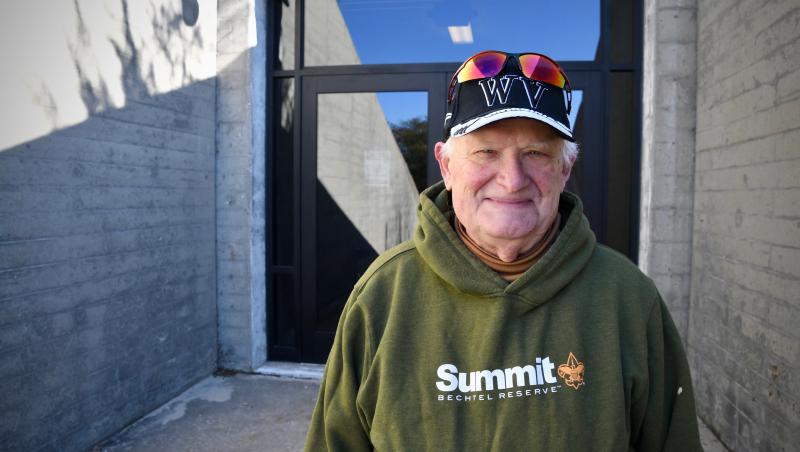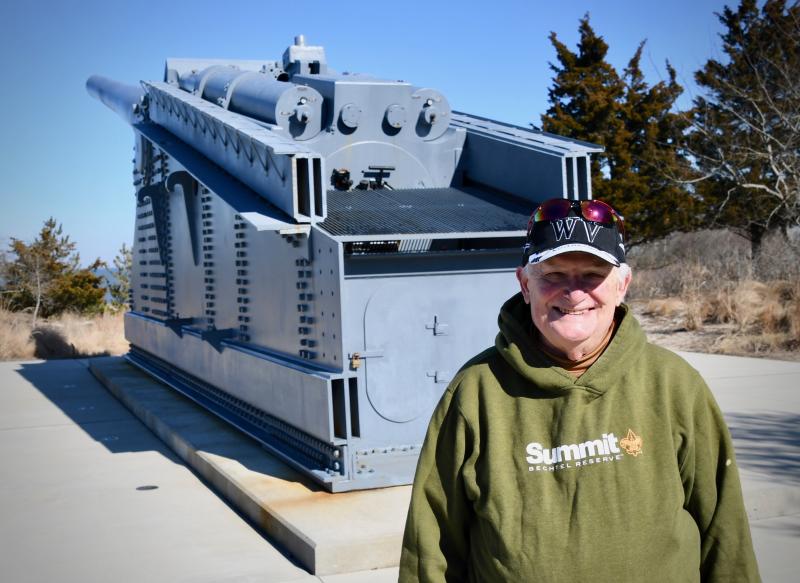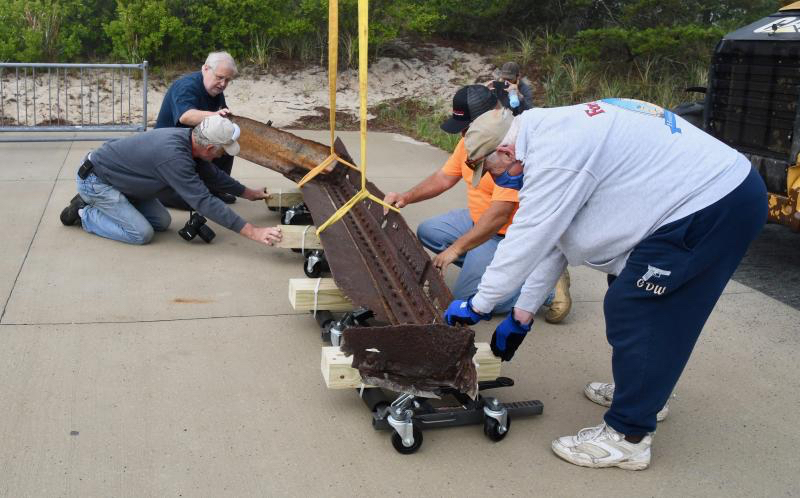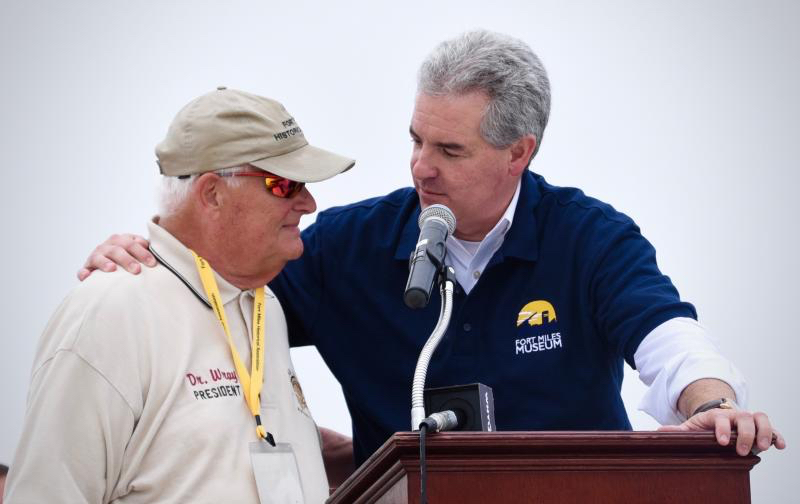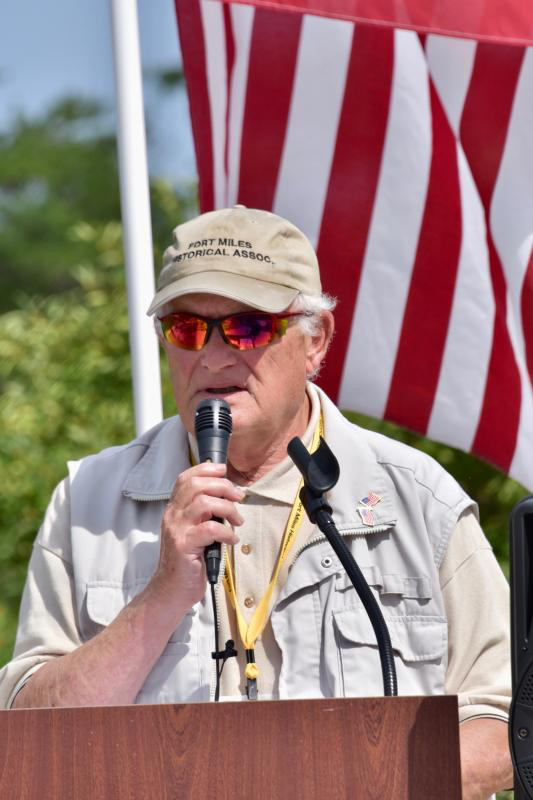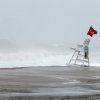History is Gary Wray's guiding light
Gary Wray has never met an artifact he wasn't dedicated to saving.
He may be stepping down as president of the Fort Miles Historical Association, but he's definitely not retiring from civic duty.
Wray, one of the association’s founders and its first president, serving since August 2003, has taken on a fresh mission to preserve Lewes' railroad history as one of the founders of the Lewes Junction Railroad & Bridge Association.
The new association has already helped pull off a major coup by finding a suitable home for the historic railroad swing bridge over the Lewes-Rehoboth Canal. Now, its members are working to secure railroad cars to display on the tracks behind the Lewes library.
Saving historic artifacts has become a central theme of the retired educator's life.
Saving Fort Miles
Before the Fort Miles group was formed, very few people knew that a historical gem was located in their backyard.
The World War II Fort Miles in Cape Henlopen State Park, considered one of the state's major historic attractions, almost slipped into oblivion.
One can only wonder what the fate of Fort Miles would have been if not for the FMHA. It's clear to Wray. “There would not be a Fort Miles,” he said.
And it was Wray who was the driving force. “I know a lot of people, and I know what I'm good at and what I'm weak at,” he said. “I guess I was the right guy in the right place at the right time.”
Retired after 35 years in the education field, Wray was able to devote a lot of his free time to the FMHA. He was able to attract highly skilled volunteers, create strong collaborations with local businesses, and forge a strong bond with the Delaware Division of Parks.
It can't be understated how much work has transpired at Fort Miles over the past 17 years. Not only have a museum and artillery park been created and barracks been restored, but also a $1 million events venue overlooking the Atlantic Ocean recently opened. Not only did the association spearhead an effort to obtain a gun barrel from the USS Missouri, it also secured an artifact from the USS Arizona. The museum now owns an artifact from the start of the war – sinking of the Arizona at Pearl Harbor – and the end of the war – Japanese surrender signing aboard the Missouri.
Tens of millions of dollars and hundreds of thousands of volunteer hours have helped transform the fort into a living history museum now known as the Fort Miles Museum and Historical Area.
“The greatest reason we've been so successful has been our cooperative relationship with the Division of Parks,” Wray said.
Another reason, he said, is the caliber of volunteers who have joined the association over the years, including engineers, electricians, plumbers, contractors and architects who have all volunteered their time and talents.
Connection to Fort Miles
Wray's tenacity, and his love of history and education were developed at an early age, when he was growing up in a coal-mining area of West Virginia.
At age 11, Wray drove his grandfather around to do daily checks of the the seven coal mines he owned. “It's always been about seeing a task and getting it done,” he said.
Wray's journey to Lewes and Fort Miles actually started at Fort Delaware. After getting his master's degree in history from the University of Delaware, he became a Delaware historian. In 1991, he received a PhD in education leadership from the University of Delaware.
“I moved to Lewes and knew nothing about Fort Miles, but as it turned out it, was like a plan coming together,” he said.
Soon, he was researching the fort to make a “Delaware in World War II” presentation as part of a Wilmington University program in Rehoboth Beach.
In the audience were several Delaware State Parks officials, including the late Lee Jennings and retired Delaware Division of Parks and Recreation director Chazz Salkin, two people who were instrumental in early work at Fort Miles.
They hit it off, and the idea to form an association was born.
One of the first projects was initiating an effort to restore Tower 3 off Route 1 just south of Dewey Beach. He said with no money, the founders picked a Sunday and walked around the Starboard with tin buckets collecting donations. The $400 they collected was the first money raised by the association.
It's taken awhile, but that project is nearing completion, with the installation of a new spiral staircase scheduled to be finished in 2022. The tower is one of several built along the Delaware coast to help Fort Miles gunners identify and pinpoint potential enemy targets in area waters.
Bookends at the museum
Wray said he and Jennings agreed that the way to attract people and spur interest in Fort Miles was to obtain World War II artifacts. Ironically, every gun at the fort was removed and scrapped when the Army vacated the area.
Wray also had a never-wavering dream of obtaining artifacts from the start and end of the war to create what he called a bookends display as the museum’s centerpiece.
Without a doubt, obtaining the Missouri gun barrel for the museum is the highlight of Wray's involvement with the association.
One can only imagine the shock when he presented the idea of shipping a 120-ton, 66-foot-long gun barrel from the USS Missouri in Norfolk across the Chesapeake Bay to Lewes by barge and rail.
And it turned out to be a race against time as the association ultimately helped save eight 16-inch gun barrels from being cut up for scrap metal.
Then the second part of the dream started to come to fruition with the donation of an artifact from the USS Arizona. On March 23, 2020, the 650-pound steel artifact arrived at Fort Miles at the start of the COVID-19 state of emergency. It was moved into the museum for storage and will be dedicated during a ceremony to be scheduled sometime this year.
As a perfect example of the connections developed by the association, FedEx donated the shipping costs of flying the artifact from Pearl Harbor, Hawaii, to Baltimore and then delivering it by truck to Cape Henlopen State Park.
One of the most unique finds
Finding artifacts has been an ongoing mission of the association, and it has resulted in some amazing acquisitions.
One of the most bizarre finds was a German U-boat flack cannon buried in the mud behind Delaware Technical Community College in Georgetown. Wray said a custodian at the college, where he was teaching in 2004, told him about a gun in the woods where a parking lot was planned.
Because Wray has studied German weaponry, he could read markings on the gun.
Much to his surprise, it was off the sunken German U-Boat 853, built under the same six-boat contract as U-Boat 858, which surrendered at Fort Miles at the end of World War II.
How the German gun ended up in a Georgetown woods is a long story. The gun, salvaged in 1967 by the late Melvin Joseph of Georgetown from the sunken sub off Block Island, R.I., was eventually donated to the college and over the years was abandoned.
“Now, it's one of the key artifacts we have,” Wray said.
The association also has an 8-inch railway gun, which is the only one known remaining in the country.
The Battery 519 museum
Even at the beginning of the Fort Miles Historical Association, Wray said the ultimate goal was to create a showplace World War II museum in the underground Battery 519 bunker. In November 2013, Wray and the association announced a $5 million, five-year plan to create the museum. In March 2016, ground was broken for the fort's artillery park leading to the museum entrance.
Most of Fort Miles is underground in a series of bunkers located throughout the park. Battery 519 housed two 16-inch guns overlooking the Atlantic Ocean.
At the time, some people probably had their doubts. The abandoned bunker had no electricity, water, heat or air conditioning. Because the two gun turrets on the ocean side had been left open for years, the elements took a toll, and animals including deer and snakes had taken up residency. “I even found a homeless guy living in there,” Wray said.
The bunker was last used by the U.S. Army in the 1960s.
Wray said first on the list was to secure the bunker and close the openings. That project was completed in 2012 at a cost of $70,000. Next was the addition of a geothermal HVAC system. Wray said without a controlled environment, plans for the museum could not move forward.
The association was able to piggyback with the City of Lewes and get a $280,000 grant from the U.S. Department of Energy for the system.
“It was pitch-black inside,” Wray said, adding they would send a member's German Shepherd into the bunker to clear out snakes before entering.
Getting electricity and water into the bunker took several years.
Wray said work inside Battery 519 got a big boost with the formation of the Bunker Busters in 2009-10. The dedicated volunteers donate more than 17,500 hours annually working on projects, and doing restoration and maintenance at Fort Miles. The association was honored in 2018 with the Governor’s Outstanding Volunteer Award.
“I still plan to work on projects at Fort Miles,” he said. “It has a very special place in my heart.”
WRAY TRIVIA
Gary Wray and Delaware's U.S. Sen. Tom Carper were born – four years apart – in the same hospital in Beckley, W.Va.
Wray served on Cape Henlopen school board 2005-10, and as vice president and president, 2005-08
30 years in the Cape district as a teacher in the 1970s, principal in the 1980s and director of secondary education 1984-93; also taught and held administrative roles in Milford and Caesar Rodney districts
Professor at Wilmington College
Three daughters, all Cape graduates
Wray hasn't totally walked away from teaching. He's helping with virtual at-home classes for two of his six grandsons.
Wray introduced Fort Miles to an international audience during an episode of the Science/Discovery Channel TV show, “Mysteries of the Abandoned”; see a clip of the show that aired in June 2020 at facebook.com/watch/?v=280580349777413.
About Fort Miles
With the ongoing threat of German ships attacking the coast, Fort Miles, the largest World War II fortification along the East Coast, was built to protect the vital shipping lanes in Delaware Bay leading to Wilmington and Philadelphia. Included in the fort were 16 underground structures; a mixture of 16-inch, 12-inch and 6-inch guns; barracks, mess hall, offices and communication centers; a hospital; recreation facilities and gymnasium; and 11 fire control towers used to spot enemy ships and help gunners mark their targets.
With more than 2,200 soldiers stationed on high alert, the heavy guns, mine fields and searchlights of Fort Miles defended the coast in the 1940s.
Into the Cold War, the role of Fort Miles shifted to highly classified missions defending against the threat of Soviet submarine operations off the coastline.
For more information, go to fortmilesha.org and lewesjunctionrr.org.
